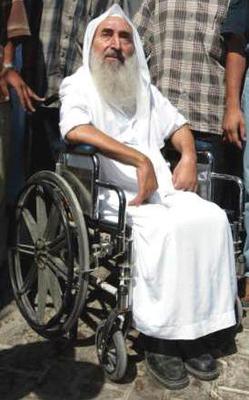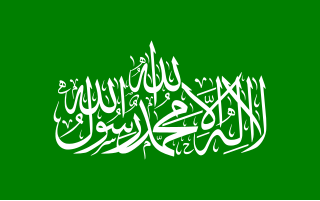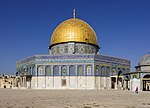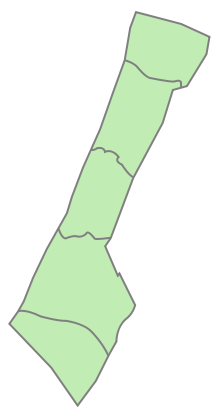
Sheikh Ahmed Ismail Hassan Yassin was a Palestinian politician and imam who founded Hamas, a Palestinian militant Islamist and nationalist organization in the Gaza Strip, in 1987.
Mohammed al-Masri, known as Mohammed Deif, is a Palestinian militant and the head of the Ezzedeen al-Qassam Brigades, the military wing of the Islamist organization Hamas.
Abdel Aziz al-Rantisi was a Palestinian political leader and co-founder of Hamas, along with Sheikh Ahmed Yassin.

Mahmoud al-Zahar is a Palestinian politician. He is a co-founder of Hamas and a member of the Hamas leadership in the Gaza Strip. Al-Zahar served as foreign minister in the Hamas-dominated Palestinian Authority Government of March 2006 that was sworn in on 20 March 2006.

The Ezzedeen Al-Qassam Brigades (EQB), named after Izz ad-Din al-Qassam, is the military wing of the Palestinian nationalist organization Hamas. Currently led by Mohammed Deif, EQB is the largest and best-equipped militant group operating within Gaza today.
Said Seyam, first name also spelled Saeed and Sayed and last name also spelled Siam, was the interior minister of the Palestinian government of March 2006. He joined Hamas and became one of its top commanders. During the 2008–2009 Gaza War, Seyam was killed in an Israeli airstrike in Jabalia. Seyam was the most senior Hamas member killed in the war, and the most senior Hamas figure killed by Israel since the death of Abdel Aziz al-Rantisi in April 2004.
Ahmed al-Jabari, also known as Abu Mohammad, was a senior leader and second-in-command of the military wing of Hamas, the Izz ad-Din al-Qassam Brigades. He was widely credited as the leading figure in the Hamas takeover of the Gaza Strip, and commanded the 2006 Hamas cross-border raid which resulted in the capture of Israeli soldier Gilad Shalit. Under his command, along with chief logistics officer Mahmoud al-Mabhouh, Hamas developed its own military weapons capability significantly by acquiring longer-range guided missiles and rockets.

Homosexuality in the Palestinian territories is considered a taboo subject; lesbian, gay, bisexual, and transgender (LGBT) people experience persecution and violence. There is a significant legal divide between the West Bank and the Gaza Strip, with the former having more progressive laws and the latter having more conservative laws. Shortly after the Jordanian annexation of the West Bank in 1950, same-sex acts were decriminalized across the territory with the adoption of the Jordanian Penal Code of 1951. In the Egyptian-occupied Gaza Strip and under Hamas' rule, however, no such initiative was implemented.
Emad Akel also spelled Imad Akel was a commander of the Izz al-Din al-Qassam Brigades, the military wing of Hamas. He was killed by the Israel Defense Forces.
The killing of Avi Sasportas and Ilan Saadon refers to two Israeli soldiers abducted by Hamas on February 16 and May 3, 1989, and subsequently killed. They were the first victims of the newly founded Palestinian militant organization. Ilan Saadon's body was found in 1996.

The abduction and killing of Nissim Toledano began on 13 December 1992, when a squad of Hamas abducted Israeli border policeman Senior Sergeant Nissim Toledano in Lod, Israel. Although the captors demanded the release of Hamas leader Sheikh Ahmed Yassin for Toledano, Toledano was killed by his captors.
Marwan Abdel Karim Ali Issa was a Palestinian militant who was the deputy commander of Hamas' military wing, the Izz ad-Din al-Qassam Brigades.

Yahya Sinwar, also spelled Yehya Sinwar, is a Palestinian politician who has been leader of Hamas within the Gaza Strip since 2017. Hamas is the Sunni Islamist political and military organization that rules the Gaza Strip.

Capital punishment in the Gaza Strip has been enforced by multiple governments, militaries, and irregular militias throughout the area's history. A large proportion of the killings have been associated with broader violent conflicts. Many of the executions could be defined as extrajudicial killings due to an incomplete or unrecorded court procedure.
Mazen Muhammad Suleiman Faqha Arabic: مازن فقها was a senior commander in the Izz al-Din al-Qassam Brigades, the military wing of Hamas. He was sentenced by Israel to 9 life terms in 2003 for his involvement in the planning and execution of multiple terrorist acts beginning in 2001. He was released as part of the 2011 Gilad Shalit prisoner exchange and deported to Gaza. After his release, he was one of the founders and leaders of Hamas' section in the West Bank.
Brigadier General Fayeq Al-Mabhouh was the Director-General of Central Operations in the Ministry of the Interior and National Security in the Gaza Strip. He was the leader of their crisis management team. His most notable recent responsibilities related to civilian disaster management, such as coordination and enforcement of restrictions during the COVID-19 pandemic.
Mahmoud Ishtiwi was killed in the Gaza Strip on 7 February 2016 by Hamas' Al-Qassam Brigades militant wing. On that day the military media of the Qassam Brigades announced that they had executed him by firing squad for behavioral and ethical transgressions that he allegedly confessed to. Human Rights Watch reported that the confession was obtain by torture. Eshtewi was survived by his two widows and his three children, and his sister Buthaina.

During the Israel-Hamas war there were a very large number of incidents of deliberate killings of people who were not actively engaged in combat. In addition to unarmed civilian, many of the soldiers and militants who were killed - and often reported simply as militants or soldiers, as if they died in combat - were not actively engaging in hostilities at their time of death. There were also multiple alleged assassinations, summary executions, deaths in custody, or other extrajudicial killings, with varying amounts of evidence to support the allegations.
The Deif family massacre was one of many during the 2014 Gaza War and one of the only cases where the intended target is known. It is now known that the strike did not hit its target, Mohammed Deif, the father of the family.







